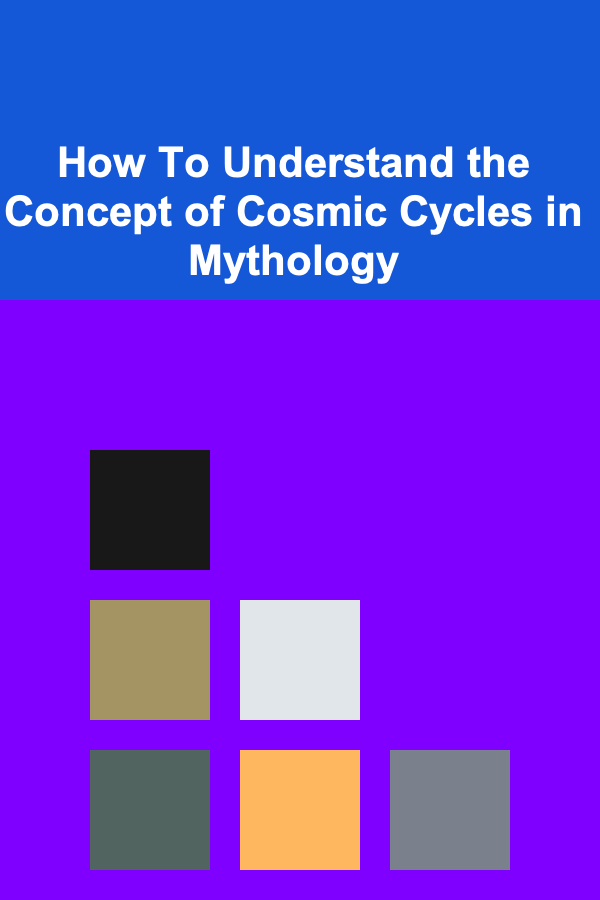
How To Understand the Concept of Cosmic Cycles in Mythology
ebook include PDF & Audio bundle (Micro Guide)
$12.99$10.99
Limited Time Offer! Order within the next:

The concept of cosmic cycles, often depicted through the lens of mythology, has fascinated scholars, philosophers, and thinkers for centuries. These cycles, which represent the eternal process of creation, destruction, and rebirth, are often integral to the mythologies of various cultures. Understanding cosmic cycles in mythology requires a nuanced perspective that blends anthropology, history, and metaphysical inquiry. This article explores the idea of cosmic cycles, examining how they manifest in different mythological traditions, their symbolic meanings, and their relevance to modern thought.
The Nature of Cosmic Cycles
In its most basic form, a cosmic cycle refers to the repeating pattern of birth, growth, decay, and rebirth that is often seen in the natural world. These cycles are mirrored in the heavens, the cycles of seasons, the lives of individuals, and the history of civilizations. While these cycles may seem linear in their course, many mythologies suggest that time and events in the universe are cyclical, returning to the same points in a never-ending loop.
The concept of cosmic cycles has profound metaphysical implications, particularly in how we perceive time, life, and existence itself. In mythology, the cycle of creation, destruction, and renewal is often portrayed as a cosmic order that governs not only the universe but also human existence. These cycles, whether they are linked to the cosmos or earthly realms, provide a lens through which individuals can explore the deeper meaning of their lives and the world around them.
Cosmic Cycles in Ancient Cultures
1. Hindu Mythology: The Yugas
One of the most prominent depictions of cosmic cycles comes from Hindu mythology. The concept of the Yugas, or "ages," is central to Hindu cosmology. According to Hindu beliefs, the universe goes through four distinct Yugas, each characterized by different levels of virtue, morality, and spiritual advancement.
The Yugas are:
- Satya Yuga (Golden Age): This is the age of truth and purity, where humanity lives in harmony with the divine and nature. It is a time of perfect moral and spiritual order.
- Treta Yuga (Silver Age): The decline begins here. Although virtue and spirituality are still present, they are not as pure as in the Satya Yuga. It is marked by the gradual rise of desire and ego.
- Dvapara Yuga (Bronze Age): The third age sees a further decline in moral and spiritual integrity. The virtues of the earlier Yugas are now overshadowed by vices such as greed, jealousy, and pride.
- Kali Yuga (Iron Age): The final and most degenerate age. It is marked by chaos, conflict, and spiritual decay. It is the current age, according to Hindu tradition, and is considered the lowest point in the cosmic cycle.
At the end of Kali Yuga, it is believed that the world will be destroyed and then reborn in a new cycle, starting again with the Satya Yuga.
2. Greek Mythology: The Ages of Man
In Greek mythology, the concept of cosmic cycles is represented through the "Ages of Man." These ages, as described by Hesiod in his work Works and Days, represent the stages of human existence from creation to decline. The Greek mythological cycle is less about the universe's cyclical nature and more about the decline of humanity over time.
The Ages of Man are:
- Golden Age: The first age, where humanity lived in peace and abundance, free from toil and suffering. It was a time of perfect harmony with the gods.
- Silver Age: This age saw a decline in virtue, with humans beginning to live in a less idealized state. They were ruled by childishness and irresponsibility, and as a result, they lived shorter lives.
- Bronze Age: Humanity becomes more warlike and violent. The inhabitants of this age are aggressive and destructive, leading to their eventual demise.
- Iron Age: The final and most degenerate age, where humanity experiences constant suffering, labor, and strife. It is considered the current age, and the future holds no hope for improvement.
In Greek mythology, the "Ages of Man" are often interpreted as a metaphor for the decline of humanity over time, with each age representing the moral and spiritual degradation of mankind.
3. Mayan Mythology: The Cycles of the Sun
The ancient Maya had a profound understanding of time, and their mythological framework included the concept of cyclical epochs. Their calendar system, which is famous for its precision, was based on the idea that the universe operates in cycles. According to Mayan mythology, the universe is created and destroyed in cycles of time.
One of the most well-known aspects of Mayan cosmology is the "Long Count" calendar, which is divided into cycles that span thousands of years. These cycles are tied to the movements of celestial bodies, particularly the sun. According to the Mayans, each cycle of time is ruled by a different deity, and each cycle ends with a period of destruction followed by rebirth.
The end of a cycle is considered a time of great transformation, with the potential for both destruction and renewal. The Maya believed that at the end of the current "age," the world would experience a cataclysmic event that would usher in a new cycle of creation.
Cosmic Cycles and the Symbolism of Time
Across various mythologies, cosmic cycles serve as a profound metaphor for understanding the nature of time. Time is often portrayed not as linear but as cyclical, reflecting the eternal return of creation, destruction, and rebirth. This cyclical view of time is deeply connected to natural rhythms, such as the changing of the seasons or the phases of the moon, which offer a tangible representation of cosmic cycles.
The symbolism of time in these cycles can also be linked to the human experience. Just as civilizations rise and fall, individuals experience cycles of growth, decay, and renewal throughout their lives. These cycles are often depicted in mythology as a reflection of the human condition, with each individual striving to navigate their own cycle of existence.
For instance, the Hindu Yugas are not only a description of the cosmos but also represent the stages of human life. The Satya Yuga symbolizes childhood and purity, the Treta Yuga represents youth and the emergence of ego, the Dvapara Yuga signifies middle age and the conflict between good and evil, and the Kali Yuga represents the challenges of old age and spiritual decline. This parallel between cosmic and human cycles provides a deep insight into how ancient cultures understood the relationship between the universe and the individual.
The Role of Deities in Cosmic Cycles
In many mythological traditions, deities play a crucial role in the cycles of creation and destruction. These gods and goddesses are often seen as personifications of cosmic forces, and their actions are believed to influence the course of cosmic events. For example, in Hindu mythology, the god Vishnu is said to preserve the universe through his various incarnations, while Shiva is the god of destruction, whose dance is said to bring about the dissolution of the universe, only to make way for new creation.
Similarly, in Greek mythology, the god Zeus represents order and justice, overseeing the cosmic balance. The god of time, Kronos, is often depicted as a figure that governs the cyclical nature of existence, representing both the destructive and regenerative aspects of time.
These deities not only embody the forces of the cosmos but also serve as intermediaries between the divine and human realms. Through their actions and myths, they help humans understand their place in the cosmic order and provide guidance for navigating the cycles of life.
The Metaphysical Implications of Cosmic Cycles
The concept of cosmic cycles in mythology carries profound metaphysical implications. It suggests that the universe operates on a grand, cyclical scale that transcends human perception of time. This view of time as cyclical challenges the common notion of linear progress, where each event leads to the next in a straight line. Instead, cosmic cycles suggest a more complex, interconnected system in which events repeat, evolve, and interrelate.
For those who subscribe to this view, the cyclical nature of time offers a sense of continuity and connection with the past and the future. It suggests that the struggles and challenges of the present are part of a larger, ongoing process that has existed since the beginning of time and will continue indefinitely.
Furthermore, the cyclical view of time is often tied to the idea of reincarnation, as seen in Hindu and Buddhist traditions. According to this belief, individual souls pass through numerous lifetimes, experiencing cycles of birth, death, and rebirth. The cycle of life and death, in this context, mirrors the cosmic cycles of creation and destruction, offering a model for understanding the soul's journey through time.
Cosmic Cycles in Modern Thought
The concept of cosmic cycles has not only influenced ancient and medieval thought but continues to shape modern philosophical and scientific inquiry. In modern cosmology, the idea of cyclical time is explored through theories such as the Big Bang and the Big Crunch. These theories propose that the universe may go through cycles of expansion and contraction, with the potential for an infinite series of rebirths.
Furthermore, the cyclical view of time has influenced modern spiritual movements, particularly those related to New Age philosophies. Many contemporary thinkers embrace the idea of cosmic cycles as a way of understanding the interconnectedness of all life and the universe. These cycles are often viewed as a source of spiritual growth and renewal, reflecting the ongoing process of evolution and transformation.
Conclusion
The concept of cosmic cycles in mythology provides a profound framework for understanding the universe, time, and the human condition. By exploring how various cultures conceptualize these cycles, we gain insight into the deep metaphysical questions that have preoccupied humanity for centuries. From the Hindu Yugas to the Greek Ages of Man, from the Mayan calendar to modern cosmology, cosmic cycles offer a powerful metaphor for understanding the rhythms of existence and the eternal processes of creation, destruction, and rebirth. In a world that often feels uncertain and chaotic, the cyclical view of the cosmos offers hope, continuity, and the possibility of renewal.

5 Ways to Build Passive Income with Deep Learning
Read More
How to Create a Checklist for Managing Overstock During Restocking
Read More
How to Enjoy Nature Walks and Learn About Local Wildlife
Read More
How to Incorporate Multi-Functional Furniture in Your Bedroom
Read More
How to Use Job Fairs to Your Advantage
Read More
Optimizing Operations: A Comprehensive Guide for Operations Coordinators
Read MoreOther Products

5 Ways to Build Passive Income with Deep Learning
Read More
How to Create a Checklist for Managing Overstock During Restocking
Read More
How to Enjoy Nature Walks and Learn About Local Wildlife
Read More
How to Incorporate Multi-Functional Furniture in Your Bedroom
Read More
How to Use Job Fairs to Your Advantage
Read More